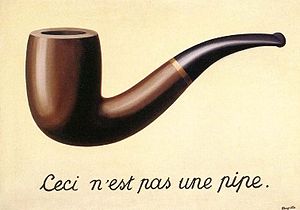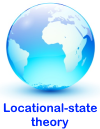The individual constituent and learning
Locational-state theory evolved from an initial enquiry into ways to specify all of the information required to take decisions. This led to an enquiry into where is the required information? The concept of the determinate locational-state model applies to learning and an individual's evolution in understanding. This is very much linked to circumstances and the locational-state of the immediate social and natural environments within which an individual has existed. What a person has observed and heard at each instance in their life stages (location in time and individual's age') and where this experience took place (geographic location) and how the individual interacted on each occasion and what actions were taken, provides the cumulative life experience that moulds a person's outlook and character as well as likes and dislikes.
TruthThe impact and value of truthTruth can be considered to be at an point in time to be a state associated with a 100% probability. The impact are value of truth can be measured by a comparison of a prior assumption of the probability of a specific state of affairs compared with information that the probability is in fact different. The value of information is essentially related to levels of understanding and the significance of the message. Being told that the sun will rise tomorrow is not particularly valuable information because experience has shown most people that this is a given or highly likely event. Being informed that all land areas below an altitude of 200 metres above sea level will be flooded in three days time has two aspects of value:
- If this is an unexpected event then this information augments the level of knowledge
- For all people with houses or farms below an altitude of 200 metres above seas level this information is very valuable
The first essentially adds to the existing fund of knowledge and the second enables people to assign a value to that information measured by the degree to which people can move their families and recover valuable items. In terms of probabilities the value of information is the impact of information on the prior probabilities assigned to different possible events, referred to as priors. Therefore the amount of information received is measured by the size of the actual probability (prior 2)divided by the previously assumed probability (prior 1):
| Amount of information received | = | prior2
prior1 |
The value of the information depends upon the relationship of a person's affairs to the event concerned. Knowing the true probability of an event can result in lives, resources and money being saved. The locational-state model provides a detailed model of the determinants that influence events and as a result provides a map of probabilities of outcomes in the form of the target property states. |
|
|
A fundamental requirement for individuals to maximize the benefits they derive from all forms of communication is that the content is factual and evidence-based and not misleading. The cumulative benefit of the learning curve and tacit knowledge is that it is based on a process of the realization of a long series of truths or lessons learned self-tested and rationalized and above all, evidence-based. These truths might not be recognized as such but rather they might be the realization of "what works". As a result tacit knowledge has a foundation of multiple tested truths. William James observed that, "
Truth is what happens." Now, it is self-evident that those involved in the events that "
happened" will "
know what happened" as an event. However, why this event happened and how this event is described can depend heavily on the motivations of each person involved and their willingness to describe both what happened and what the basis of their rationale as to why it happened, is. Today we witness the widespread references to "fake news" and the growing service of "fact checking". The growth in so-called social media has led to an increased reliance on explicit knowledge and a decline in tacit knowledge in people's daily existence. Even educational establishments are concentrating essentially on explicit knowledge, as observed by Elton Mayo, and constituents are left without any direct experience against which to test what is stated. It is notable that people with more life experience tend to spend less time on social-media and become less involved in becoming enthusiastic about "
changing things for the better", simply because as a simple course of events and experience there is a realization that there are no convenient means to do so which are defended by a constitution, to bring about desired change. Thus, in spite of the rhetoric of hope and opportunities, the reality is somewhat different. During the last 50 years, in spite of significant economic advances, there has been within the last 25 years significant groups of constituents whose situation in terms of income and opportunities appear to be declining. At the same time the backdrop of media and political rhetoric has maintained the discourse of promotion of the benefits of the economic system. This rhetoric does not accord with the experience of large groups of constituents who do not enter into this discussion as a result of disillusionment and as a result their significance is under-estimated and marginalized from political consideration and even debate.
Truth as what isAs can be appreciated, rhetoric and the organization of explicit knowledge can be open to a priori interpretation leading to descriptions that do not represent the facts. Therefore sometimes it is more informative simply to state a series of facts to enable those receiving this information to make the connections and draw inferences. This revisits the concept of "complete" and "incomplete data sets". Naturally, by extending the range of data collected on a topic it is possible to assess this information and draw conclusions more easily than only receiving less data. The challenge is to separate out the information that is not relevant to the requirements of the person receiving the information. The purpose of the locational-state model is to identify the data required and to extend its scope to ensure that the data set is as complete as possible in providing a better sight of "what is".
Irrational presumptions
Alfred Korbzyski alerted people to the fact that, "
The map is not the territory" but the map is only a representation of the truth just as words and messages so the rational individual probes the messages or model to assess its degree of representation of the truth. The Belgian surrealist artist René Magritte created the painting, "
The Treachery of Images" in 1929 also known as "
This is not a pipe" shown on the left. His explanation was that if he had written below the image, "This is a pipe" we would have been lying. Which of course is true.
The dangers of communication based on images and messages is that there is often very little in the messages that permits rational questions because of a lack of details. In the political and faith realms quite often messages received are assertions and those receiving them are discouraged from questioning their logic or seeking evidence.
The basic subject matter of Alfred Korzybski's work on General Semantics was a general theory of evaluation which naturally depends upon adequate information and therefore locational-state theory is in the same general area of investigation. Korzybski, for example, made reference to the fact that all events are time-bound which appears to be the same concept as the time locational aspect of locational-state theory.
The 4th and 5th EstatesThe press and media (newspapers) are often referred to as the 4th Estate. The nature of the commercial models and role of advertising in the business sustainability model has changed what was considered to be a pure journalism function of reporting facts as they are in an independent and unbiased fashion, to one that shapes its communication to favour specific point of view, perspectives on policies and political parties. As a result an alternative media has grown facilitated by the W3 but which does not receive, in general as much corporate advertising and mainstream media. On the other have "social media" which are very much concerned with collecting data on readership profiles to support political and advertising intelligence are better funded and to a large extent have taken over the function of delivering news. The lack of regulations relating to independence and unbiased content and balanced exposure of different points of view has caused a high degree of censorship imposed by private corporations on the majority of news content.
